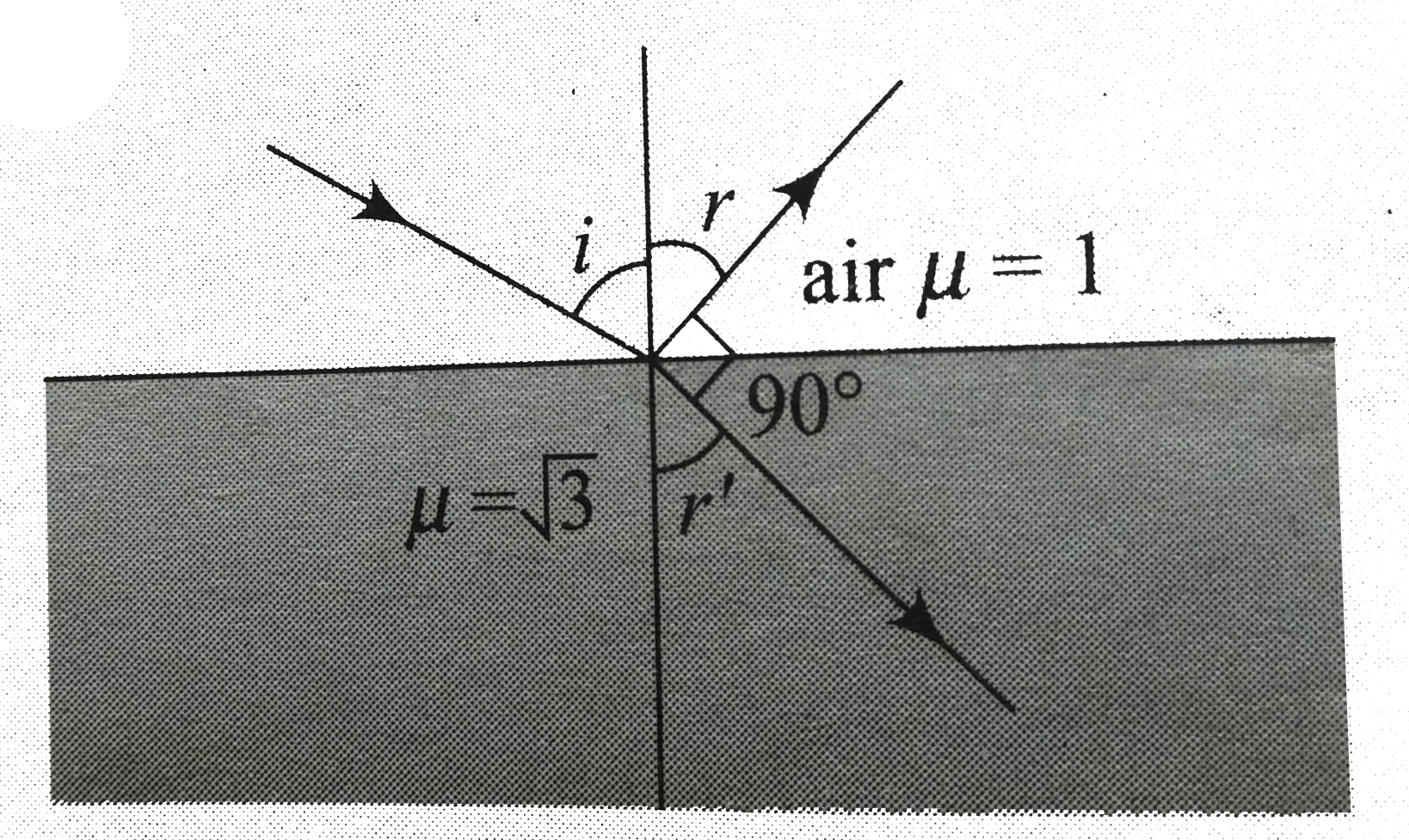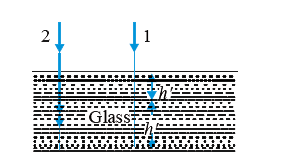A ray of light-is incident on glass at the polarising angle ip. Find the angle between the reflected and refracted rays.
The correct Answer is:90∘
To solve the problem of finding the angle between the reflected and refracted rays when light is incident on glass at the polarizing angle ip, we can follow these steps:
1. Understanding the Setup:
- We have a ray of light incident on the interface between air and glass at the polarizing angle ip.
- At this angle, some light is reflected, and some is refracted.
2. Applying Brewster's Law:
- According to Brewster's Law, the polarizing angle ip is related to the refractive index n of the glass by the equation:
tan(ip)=n
3. Applying Snell's Law:
- Snell's Law relates the angles of incidence and refraction:
sin(ip)sin(r)=n
- Here, r is the angle of refraction.
4. Relating Angles:
- From the geometry of the situation, we know that:
ip+r=90∘
- This is because the angle of incidence and the angle of refraction add up to 90∘ at the polarizing angle.
5. Finding the Angle Between Reflected and Refracted Rays:
- The angle of reflection is equal to the angle of incidence, so the angle of reflection is also ip.
- The angle between the reflected ray and the refracted ray can be calculated as:
Angle between reflected and refracted rays=ip+r
- Since ip+r=90∘:
Angle between reflected and refracted rays=90∘
Final Answer:
The angle between the reflected and refracted rays is 90∘.
---
- We have a ray of light incident on the interface between air and glass at the polarizing angle ip.
- At this angle, some light is reflected, and some is refracted.
- According to Brewster's Law, the polarizing angle ip is related to the refractive index n of the glass by the equation:
tan(ip)=n
- Snell's Law relates the angles of incidence and refraction:
sin(ip)sin(r)=n
- Here, r is the angle of refraction.
- From the geometry of the situation, we know that:
ip+r=90∘
- This is because the angle of incidence and the angle of refraction add up to 90∘ at the polarizing angle.
- The angle of reflection is equal to the angle of incidence, so the angle of reflection is also ip.
- The angle between the reflected ray and the refracted ray can be calculated as:
Angle between reflected and refracted rays=ip+r
- Since ip+r=90∘:
Angle between reflected and refracted rays=90∘
The angle between the reflected and refracted rays is 90∘.
Similar Questions
A ray of light is incident on a transparent medium at polarizing angle. What is the angle between the reflected ray and the refracted ray .
View SolutionA ray of light is incident on a transparent glass slab of refractive index √3. If the reflected and refracted rays are mutually perpendicular, what is the angle of incidence?

View Solution
Knowledge Check
Light is incident on a glass surface at polarising angle of 57.5∘ Then the angle between the incident ray and the refracted ray is
A57.5∘B115∘C205∘D145∘A ray of light strikes a transparent rectangular slab of refractive index √2 at an angle of incidence of 45∘. The angle betweent the reflected and refracted rays is
A75∘B90∘C105∘D120∘
A ray of light falls on a glass plate of refractive index μ=1.5.
What is the angle of incidence of the ray if the angle between the reflected and
refracted rays is 90∘?
View SolutionA ray of light falls on a glass plate of refractive index μ=1.5.
What is the angle of incidence of the ray if the angle between the reflected and
refracted rays is 90∘?
View SolutionA ray of light is incident at an angle i from denser to rare medium. The reflected and the refracted rays are mutually perpendicular. The angle of reflection and the angle of refraction are respectively r and r'. Then the critical angle will be:

View SolutionA ray of ordinary light is travelling in air. It is incident on air glass pair at a polarising angle of 56∘. Find the angle of refraction in glass.
View SolutionA : When an unpolarised light is incident on a glass plate at Brewster angle, the reflected ray and refracted ray are matually perpendicular.
R : The refractive index of glass is equal to sine of the angle of polarisation.
View SolutionUnpolarized light is incident on a plane glass surface. What should be the angle of incidence so that the reflected and refracted rays are perpendicular to eachother ?
View Solution
